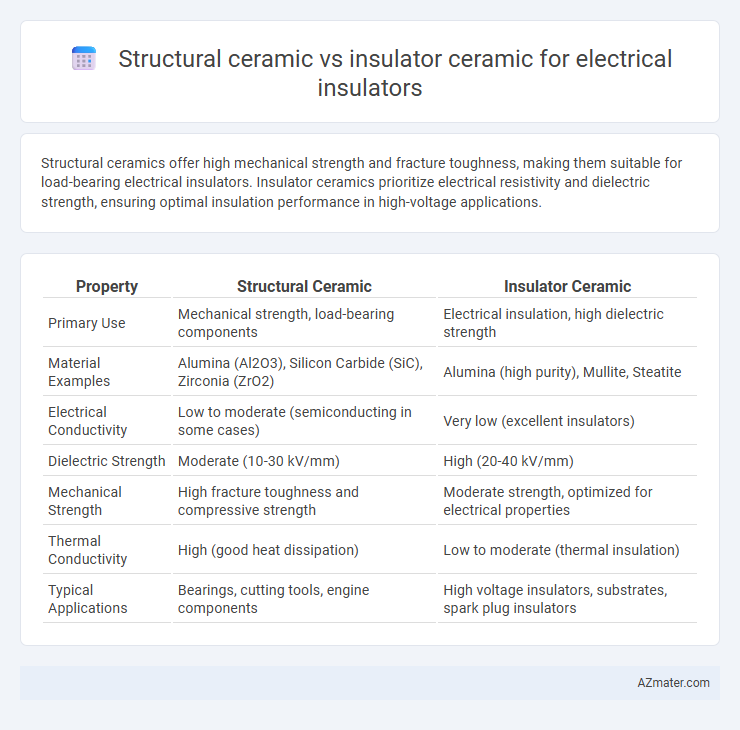Structural ceramics offer high mechanical strength and fracture toughness, making them suitable for load-bearing electrical insulators. Insulator ceramics prioritize electrical resistivity and dielectric strength, ensuring optimal insulation performance in high-voltage applications.
Table of Comparison
| Property | Structural Ceramic | Insulator Ceramic |
|---|---|---|
| Primary Use | Mechanical strength, load-bearing components | Electrical insulation, high dielectric strength |
| Material Examples | Alumina (Al2O3), Silicon Carbide (SiC), Zirconia (ZrO2) | Alumina (high purity), Mullite, Steatite |
| Electrical Conductivity | Low to moderate (semiconducting in some cases) | Very low (excellent insulators) |
| Dielectric Strength | Moderate (10-30 kV/mm) | High (20-40 kV/mm) |
| Mechanical Strength | High fracture toughness and compressive strength | Moderate strength, optimized for electrical properties |
| Thermal Conductivity | High (good heat dissipation) | Low to moderate (thermal insulation) |
| Typical Applications | Bearings, cutting tools, engine components | High voltage insulators, substrates, spark plug insulators |
Introduction to Ceramic Materials in Electrical Insulation
Structural ceramics in electrical insulation offer high mechanical strength and thermal stability, making them ideal for components exposed to physical stress and elevated temperatures. Insulator ceramics primarily provide excellent electrical resistivity and dielectric properties, crucial for preventing current leakage and ensuring safety in electrical systems. Understanding the distinct roles of these ceramics enhances the design and reliability of advanced electrical insulation solutions.
Definition: Structural Ceramics vs. Insulator Ceramics
Structural ceramics are advanced materials designed to withstand mechanical stress, high temperatures, and wear, making them ideal for load-bearing applications; they exhibit high hardness, fracture toughness, and thermal stability. Insulator ceramics, also known as electrical ceramics, primarily serve to prevent electrical conduction by possessing high dielectric strength, low electrical conductivity, and excellent insulation properties under various environmental conditions. While structural ceramics focus on mechanical durability, insulator ceramics specialize in electrical insulation performance for components like substrates, insulators, and capacitors.
Material Composition and Microstructure Differences
Structural ceramics used for electrical insulators typically comprise alumina (Al2O3), silicon nitride (Si3N4), or zirconia (ZrO2), featuring dense microstructures with high fracture toughness and mechanical strength. Insulator ceramics primarily consist of porcelain or steatite, characterized by porosity and a glassy phase that provides excellent dielectric properties and electrical insulation. The microstructure of structural ceramics shows tightly bonded grains for mechanical resilience, while insulator ceramics possess intergranular phases that enhance electrical resistance but reduce mechanical durability.
Mechanical Properties Comparison
Structural ceramics exhibit significantly higher mechanical strength, hardness, and fracture toughness compared to insulator ceramics used in electrical applications. While insulator ceramics prioritize dielectric properties and electrical resistance, their mechanical properties such as flexural strength and impact resistance are generally lower. Structural ceramics like alumina and silicon carbide provide enhanced durability and wear resistance, making them ideal for high-stress electrical insulator components exposed to mechanical loads.
Electrical Insulation Capabilities
Structural ceramics offer moderate electrical insulation capabilities with high mechanical strength and thermal stability, making them suitable for applications requiring both durability and insulation. Insulator ceramics, such as alumina and zirconia, provide superior electrical insulation properties due to their high dielectric strength, low electrical conductivity, and resistance to electrical breakdown. These insulator ceramics excel in preventing current flow and maintaining performance in high-voltage environments, ensuring reliable electrical insulation in critical electrical and electronic components.
Thermal Stability and Performance
Structural ceramics exhibit superior thermal stability with high melting points often exceeding 2,000degC, making them ideal for applications requiring mechanical strength and resistance to thermal shock. Insulator ceramics, such as alumina and zirconia, offer excellent electrical insulation and maintain performance under elevated temperatures up to 1,500degC, balancing thermal stability with dielectric properties. Performance-wise, structural ceramics prioritize load-bearing capacity and thermal endurance, while insulator ceramics optimize low electrical conductivity and consistent dielectric strength in high-temperature environments.
Applications of Structural Ceramics in Electrical Systems
Structural ceramics in electrical systems are utilized for components that require exceptional mechanical strength and thermal stability, such as insulator supports, housings, and substrates for electronic circuits. These ceramics, including alumina and silicon carbide, withstand high stress and temperature environments, making them ideal for power transmission equipment and semiconductor manufacturing tools. Unlike insulator ceramics primarily designed for electrical isolation, structural ceramics combine insulation with durability, enabling reliable protection and mechanical performance in demanding electrical applications.
Applications of Insulator Ceramics in Electrical Systems
Insulator ceramics are crucial in electrical systems for their superior dielectric properties and high resistance to electrical conductivity, making them ideal for applications such as isolators, substrates in electronic devices, and insulators in high-voltage equipment. Unlike structural ceramics, which prioritize mechanical strength and wear resistance, insulator ceramics like alumina and zirconia provide effective electrical insulation while withstanding thermal stress in transformers, circuit breakers, and power transmission lines. Their ability to maintain insulation integrity under extreme electrical loads enhances the safety, efficiency, and longevity of electrical components in industrial and power distribution networks.
Advantages and Limitations of Each Ceramic Type
Structural ceramics offer superior mechanical strength, high hardness, and excellent thermal stability, making them ideal for load-bearing electrical insulator applications. However, their brittleness and higher cost limit widespread use in complex insulating components. Insulator ceramics excel in electrical resistivity and dielectric strength, providing effective insulation under high voltage but often suffer from lower mechanical toughness and vulnerability to thermal shock.
Selection Criteria for Electrical Insulator Applications
Selection criteria for electrical insulator applications prioritize dielectric strength, thermal stability, and mechanical robustness when choosing between structural ceramics and insulator ceramics. Structural ceramics offer superior mechanical properties such as high fracture toughness and wear resistance but may have lower dielectric performance compared to insulator ceramics, which provide excellent electrical insulation, high resistivity, and low dielectric loss. Optimal selection depends on specific application requirements like operating temperature, electrical stress, mechanical load, and environmental exposure to ensure reliability and performance.

Infographic: Structural ceramic vs Insulator ceramic for Electrical insulator
 azmater.com
azmater.com